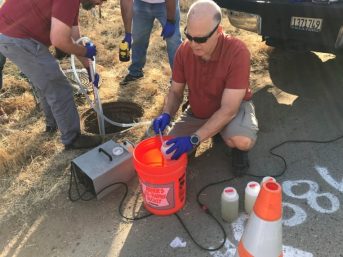Fecal contamination study shows sewers have unique microbial, chemical characteristics

The ongoing work, launched last year, involves examining whether the microbial community that lives inside sanitary sewer pipes is unique to sanitary sewer pipes. A parallel study is examining whether the chemical properties of the wastewater also are unique.
Researchers have found that the microbial community coating the inside of the sewer pipes – known as biofilm – has a different DNA-based community profile from the microbial community that lives inside storm drain systems. Meanwhile, via the use of nontargeted chemical analysis, researchers have found that the chemical fingerprint of the contents in sanitary sewer pipes is different from the chemical fingerprint in storm drain pipes.
Both studies are now expanding to look at how reliably these trends hold up with samples collected from different locations with different pipe characteristics at different times.
The goal of both studies is to shed light on whether leaking sewer pipes could be responsible for the human fecal contamination found in urban waterways across Southern California during wet weather.
More news related to: Microbial Source Tracking, Microbial Water Quality